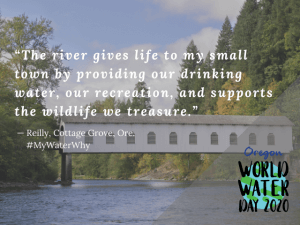What’s Your Water Why?

Wildflowers and wetlands. Tribal sovereignty. Young farmers, brewers and Oregon newcomers. My niece and nephew. Climate change. Because we can do more with so much less. And everyone deserves to drink water from their tap or eat fish from our rivers without fear. Everything we love depends on water. #MyWaterWhy
By Stacey Dalgaard, Water Outreach Director, Oregon Environmental Council
 This week marks the beginning of the third Oregon World Water Day campaign organized by Oregon Environmental Council. We started this campaign to help elevate the conversation around water in Oregon and bring organizations, businesses, water advocates, Tribes, policymakers and people across the state together around our shared dependence on this precious resource.
This week marks the beginning of the third Oregon World Water Day campaign organized by Oregon Environmental Council. We started this campaign to help elevate the conversation around water in Oregon and bring organizations, businesses, water advocates, Tribes, policymakers and people across the state together around our shared dependence on this precious resource.
In the three years that I’ve been a part of the OEC team, I’ve had the pleasure to meet Tribal members from across the Northwest, farmers, river and environmental justice advocates, the people that make sure our wastewater is clean before it goes back into the river, elementary and high school students, policymakers, academics and innovators, and so many more people who are all part of shaping Oregon’s water future.

These people have taught me how our current ways of managing water succeed and fail, what a water-scarce future will look like, that the next generation aspires for more, and that we have an incredible opportunity to envision a more resilient water future in front of us.
However, we are facing water uncertainty due to a changing climate, aging infrastructure that is past its expiration date or inadequate for our current community needs, and a lack of ongoing investment in clean water. When infrastructure fails, it can be dramatic – like bridges collapsing and dams spilling over. But it can also be hard to see and easy to ignore until it happens.
Recent Headlines:
- No safe drinking water on reservation leaves thousands improvising
- PSU study finds low-income areas in Portland are most at risk for severe weather
- Oregon governor declares state of emergency for Pendleton flooding
- ‘Forever chemicals’ found in water at Oregon National Guard bases, school
- ‘Flushable’ wipes cause nearly 10,000 gallons of raw sewage to spill into creeks
- Oregon’s water infrastructure hasn’t been upgraded for 100 years. Some think it’s time to fix that.
It’s time to shift away from thinking about our natural and built environments as separate spaces, and start investing in solutions that break down these silos. Rivers, wetlands and groundwater aquifers are vital parts of our water infrastructure. They are the backbone of healthy communities and a robust economy.
Which is why we are pleased to see that the Governor’s 100-year Water Vision is prioritizing ecosystems and natural infrastructure investments as key strategies in Oregon’s plan for our water future.
 Our job in the next decade is to figure out how to do more with less water and start working with nature instead of against it. In my conversations with people across Oregon, I am most struck by how big the opportunity is to make an immediate impact on our water future with the right investments, as well as the many creative and passionate Oregonians that are already changing this paradigm across the state.
Our job in the next decade is to figure out how to do more with less water and start working with nature instead of against it. In my conversations with people across Oregon, I am most struck by how big the opportunity is to make an immediate impact on our water future with the right investments, as well as the many creative and passionate Oregonians that are already changing this paradigm across the state.
Today, we can all stand up for water and our future as a healthy and resilient state by sharing why water matters to our lives, livelihoods and the world around us.
Join us in celebrating World Water Day this March by sharing your #MyWaterWhy at oregonworldwaterday.org and on social media to help elevate what’s important for Oregon today and future generations.
#MYWATERWHY
Help build a collective voice for Oregon’s water resources. Join Oregonians from across the state as we celebrate our common interest in preserving the health of our rivers and drinking water for Oregon today and future generations.




